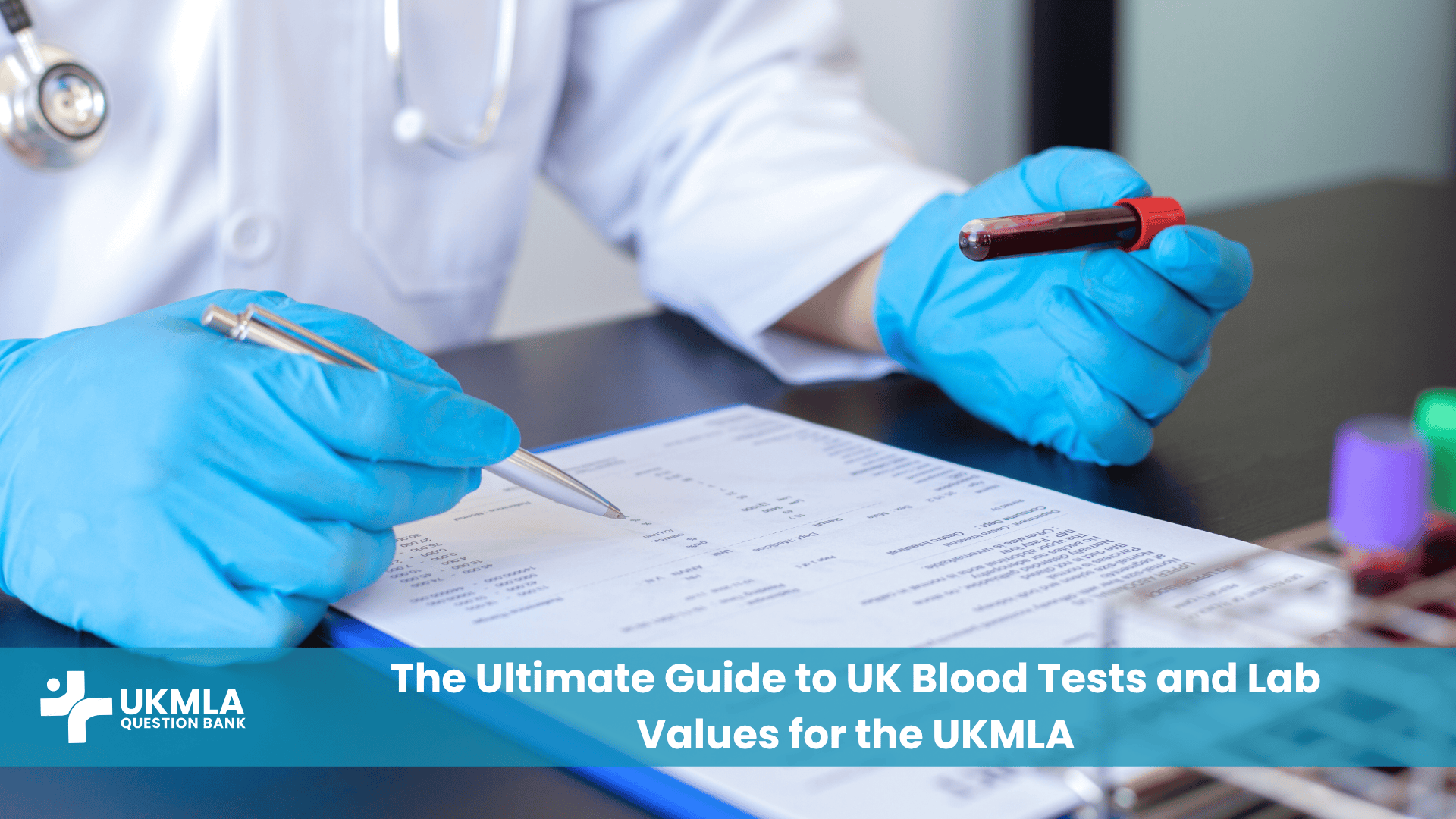Introduction
Understanding uk lab values ukmla candidates are expected to know is a fundamental pillar of medical education and a critical skill for exam success. It goes far beyond simply memorizing normal ranges; it involves recognizing clinical patterns, understanding the pathophysiology behind the numbers, and making safe, evidence-based decisions. This is a core competency tested thoroughly in both the AKT and CPSA components of the UK Medical Licensing Assessment.
This guide is designed to be your ultimate reference, moving you from rote learning to a practical, deep understanding of what the results truly mean. We will break down the most common blood tests, explore the significance of each value, and use clinical case studies to put the knowledge into the context you’ll face on exam day and as a junior doctor on the wards.
Table of Contents
ToggleThe Core Panels: FBC, U&Es, and LFTs
These three panels are the bedrock of hospital medicine and will undoubtedly feature heavily in your exam. A solid understanding here is non-negotiable.
Full Blood Count (FBC): A Deeper Look at Haematology
The FBC provides a snapshot of the cellular components of the blood. It gives clues to infection, inflammation, bleeding disorders, and nutritional deficiencies.
Table 1: Key Components of the Full Blood Count (FBC)
| Parameter | Normal UK Range (Approx.) | Significance |
|---|---|---|
| Haemoglobin (Hb) | 130-170 g/L (Male) 120-150 g/L (Female) | Low indicates anaemia; High indicates polycythaemia. |
| White Cell Count (WCC) | 4.0-11.0 x 10⁹/L | High (leukocytosis) suggests infection/inflammation; Low (leukopenia) suggests immunosuppression. |
| Platelets (Plt) | 150-400 x 10⁹/L | Low (thrombocytopenia) increases bleeding risk; High (thrombocytosis) increases clotting risk. |
| Mean Corpuscular Vol (MCV) | 82-99 fL | Describes red cell size: Low=microcytic, Normal=normocytic, High=macrocytic. |
Beyond the basics, look at the WCC differential. A neutrophilia (high neutrophils) points towards a bacterial infection, while a lymphocytosis (high lymphocytes) suggests a viral cause. For anaemia, the MCV is crucial. Microcytic anaemia (low MCV) is most commonly due to iron deficiency. Normocytic anaemia (normal MCV) is often due to chronic disease or acute blood loss. Macrocytic anaemia (high MCV) points towards Vitamin B12 or folate deficiency.
Urea & Electrolytes (U&Es): Assessing Renal and Metabolic Health
The U&Es panel is crucial for assessing kidney function and electrolyte balance, a core part of the nephrology and urology essentials for the UKMLA.
Table 2: Key Components of Urea & Electrolytes (U&Es)
| Parameter | Normal UK Range (Approx.) | Significance |
| Sodium (Na+) | 135-145 mmol/L | Low (hyponatremia) and High (hypernatremia) are common and serious imbalances. |
| Potassium (K+) | 3.5-5.3 mmol/L | Both low (hypokalemia) and high (hyperkalemia) can cause life-threatening arrhythmias. |
| Urea | 2.5-7.8 mmol/L | A marker of waste products; high levels suggest dehydration or kidney injury. |
| Creatinine | 60-120 µmol/L | A more reliable marker of kidney function than urea. High levels indicate impaired renal clearance. |
Hyperkalemia is a medical emergency due to its cardiotoxicity, causing tall, tented T-waves on an ECG. Hyponatremia requires careful assessment of the patient’s fluid status (hypovolaemic, euvolaemic, or hypervolaemic) to determine the cause and correct management.
Liver Function Tests (LFTs): Hepatocellular vs. Cholestatic Patterns
LFTs help to determine the nature and severity of liver injury. The key is to recognize patterns. For a deeper understanding of what each test is for, resources like Lab Tests Online UK are invaluable.
Clinical Pearl: Don’t interpret LFTs in isolation. The pattern of derangement is more informative than any single value. Is it a hepatocellular picture (damage to liver cells) or a cholestatic picture (problem with bile flow)?
Table 3: Differentiating LFT Patterns
| Pattern | Key Markers Raised | Common Causes |
| Hepatocellular Injury | ALT and AST are disproportionately high compared to ALP. | Viral hepatitis, paracetamol overdose, ischaemic hepatitis. |
| Cholestatic Picture | ALP and GGT are disproportionately high compared to ALT/AST. | Gallstones (biliary obstruction), primary biliary cholangitis. |
Furthermore, albumin and prothrombin time (PT/INR) are crucial markers of the liver’s synthetic function. In chronic liver disease, the liver can’t produce these proteins effectively, leading to low albumin and a prolonged PT/INR.
Inflammatory Markers and Coagulation Screen
These tests help quantify inflammation and assess the blood’s ability to clot.
C-Reactive Protein (CRP) and Erythrocyte Sedimentation Rate (ESR)
Both CRP and ESR are non-specific markers of inflammation.
CRP: An acute-phase reactant that rises and falls quickly (within hours to days). This makes it excellent for monitoring acute inflammation and a patient’s response to treatment, such as antibiotics for an infection. A normal level is typically <5 mg/L.
ESR: An indirect measure of inflammation that rises and falls slowly (over days to weeks). This makes it more useful for monitoring chronic inflammatory conditions like rheumatoid arthritis, polymyalgia rheumatica, or temporal arteritis.
Understanding the Coagulation Screen (PT, APTT, INR)
This panel is essential for assessing bleeding risk and monitoring anticoagulant therapy.
Prothrombin Time (PT) / INR: Measures the extrinsic and common coagulation pathways. It is prolonged by warfarin, vitamin K deficiency, and liver disease. The INR (International Normalised Ratio) standardizes the PT result, making it comparable between labs, and is used to monitor warfarin therapy.
Activated Partial Thromboplastin Time (APTT): Measures the intrinsic and common pathways. It is prolonged by unfractionated heparin and underlying conditions like haemophilia.
Key Endocrine and Cardiac Markers
These specialized tests are crucial for diagnosing some of the most common and high-yield conditions.
Thyroid Function Tests (TFTs): TSH, T4, and T3
Interpreting TFTs is a core skill in endocrinology. The TSH (Thyroid-Stimulating Hormone) is the most important first test, as it reflects the pituitary’s response to circulating thyroid hormone levels.
Primary Hypothyroidism: High TSH, Low T4. The thyroid gland itself has failed.
Primary Hyperthyroidism: Low TSH, High T4/T3. The thyroid gland is overactive.
Sick Euthyroid Syndrome: In acutely unwell patients, TFTs can be abnormal without true thyroid disease. Typically, TSH, T4, and T3 are all low. The rule is to avoid checking TFTs in acutely ill patients unless there is a strong suspicion of thyroid dysfunction. For more on this, refer to the UKMLA endocrinology essentials guide.
Cardiac Markers: The Role of Troponin
Troponin (T or I) is a highly sensitive and specific marker of myocardial cell injury. An elevated troponin level in the context of a suggestive history (e.g., chest pain) is diagnostic of a myocardial infarction. It’s important to look at the trend; a rise and/or fall in troponin levels is more significant than a single reading. This is a critical concept in the UKMLA cardiology essentials guide.
Interpreting Arterial Blood Gas (ABG) Results
The ABG is a vital tool in assessing acutely unwell patients, providing a rapid assessment of oxygenation, ventilation, and acid-base status. A systematic approach is key.
Table 4: A 4-Step Method for ABG Interpretation
| Step | Question | Finding & Interpretation |
| 1. pH | Is the patient acidotic or alkalotic? | pH < 7.35 = Acidosis; pH > 7.45 = Alkalosis. |
| 2. CO₂ | Is the primary problem respiratory? | PaCO₂ > 6.0 kPa = Respiratory Acidosis. PaCO₂ < 4.7 kPa = Respiratory Alkalosis. |
| 3. HCO₃⁻ | Is the primary problem metabolic? | HCO₃⁻ < 22 mmol/L = Metabolic Acidosis. HCO₃⁻ > 26 mmol/L = Metabolic Alkalosis. |
| 4.Compensation | Is the body trying to compensate? | Look for the opposing system moving to correct the pH (e.g., low HCO₃⁻ in respiratory alkalosis). |
Understanding uk lab values ukmla: Putting It All Together
Recognizing patterns is the key skill. True mastery comes from applying your knowledge, which is the focus of interpreting clinical data for the UKMLA AKT.
Case Study 1: Interpreting Labs in Acute Kidney Injury
A patient presents with vomiting. Bloods show: Na+ 130, K+ 5.8, Urea 25, Creatinine 250.
Interpretation: The hyponatremia, hyperkalemia, and raised urea/creatinine are classic for an Acute Kidney Injury (AKI). The vomiting (fluid loss) is a likely pre-renal cause. This patient needs urgent fluid resuscitation and monitoring. Referencing official guidance, like the NICE CKS on AKI, is the next step in management.
Case Study 2: Deducing the Cause of Anaemia from an FBC
A patient’s FBC shows: Hb 95, MCV 72.
Interpretation: The low Hb confirms anaemia. The low MCV indicates it is a microcytic anaemia. The most common cause of microcytic anaemia is iron deficiency, so the next steps would be to check iron studies (ferritin).
Frequently Asked Questions (FAQ) about UK Lab Values for UKMLA
Both are markers of kidney function, but creatinine is more reliable. Urea is heavily influenced by non-renal factors like dehydration and protein intake, whereas creatinine is a more direct reflection of the glomerular filtration rate (GFR).
Not always. For example, an isolated raised ALP can be caused by bone problems (like Paget’s disease or bony metastases) or even pregnancy. AST is also found in muscle cells and can be raised after a significant muscle injury.
About half of the calcium in the blood is bound to albumin. If a patient has low albumin (e.g., in chronic liver disease or malnutrition), their total calcium will be low, but their active (ionised) calcium might be normal. The “adjusted” level corrects for this to give a more accurate picture.
A high INR (e.g., >1.5) means the blood is taking longer than normal to clot. This could be due to warfarin therapy (the intended effect), vitamin K deficiency, or severe liver disease (as the liver produces clotting factors).
No. While bacterial infection is a common cause of neutrophilia, other causes of a high WCC include sterile inflammation (e.g., post-surgery), trauma, steroid use, and haematological malignancies like leukaemia.
The anion gap is a calculation used in patients with metabolic acidosis ([Na⁺] + [K⁺]) – ([Cl⁻] + [HCO₃⁻]). It helps narrow down the cause. A high anion gap metabolic acidosis (HAGMA) has a specific list of important causes (remembered by mnemonics like MUDPILES).
Yes. Always use the specific reference ranges provided by the laboratory that processed the sample, as they can vary slightly between different labs and assays. The values in this guide are approximations.
The APTT is used to monitor unfractionated heparin therapy. Low molecular weight heparin (LMWH), such as enoxaparin, does not typically require monitoring.
Gamma-Glutamyl Transferase (GGT) is a sensitive marker for liver disease, particularly related to bile ducts and alcohol use. If both ALP and GGT are raised, it strongly suggests the source of the high ALP is the liver (i.e., cholestasis), not the bone.
Always interpret lab results in the context of the individual patient’s history, examination findings, and clinical condition. Never treat a number in isolation.
Conclusion
Familiarity with UK blood tests and lab values is a non-negotiable for any UKMLA candidate. While it may seem like a daunting list of numbers and ranges, a structured approach focused on clinical patterns can simplify the process. Use this guide as a foundational reference, but remember that true mastery comes from active practice. Use question banks, meticulously review the lab results of patients you see on placement, and always ask “why?” when you see an abnormal result.
By moving from simply memorizing the normal uk lab values ukmla to understanding the clinical stories they tell, you will build a deep and lasting competence. This skill is not just for passing the exam; it is a fundamental pillar of safe and effective medical practice that will serve you every single day throughout your career.




